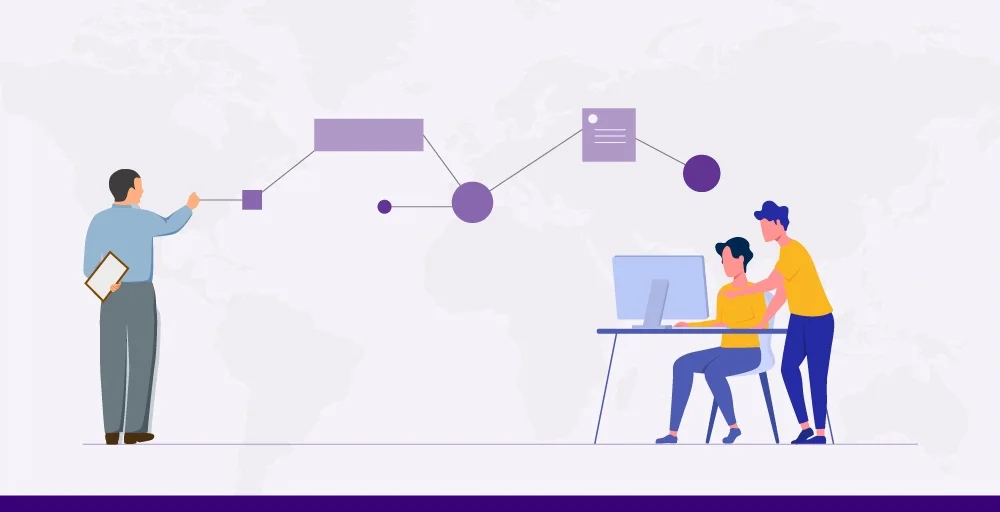In today’s busy world, team members often face problems staying connected and organized with each other. Miscommunications, lost information, and the challenges of remote work can lead to low productivity.
Without the right tools, managing projects and collaborating with team members can be difficult and frustrating. Collaboration software offers a solution to these problems.
Collaboration software provides a central platform where members can easily work on project management, document sharing, and collaboration. Moreover, they allow teams to work together smoothly from anywhere.
In this blog, we’ll explain collaboration software in detail, including its features, benefits, and types. We will also shed light on how the right collaboration software can make your team interaction more efficient. 💡
🔑 KEY HIGHLIGHTS
- Collaboration software is an application that helps the team maximize their teamwork by providing a common platform.
- A central platform that collaboration software provides will help teams increase productivity and efficiency.
- Collaboration tools increase productivity, enhance collaboration, improve communication, and provide real-time collaboration.
- When choosing collaboration tools, check their features, cost, compatibility with other software, interface, and, lastly, your business needs.
- Revolutionize your telephony collaboration with KrispCall’s unified call box features, cloud-based phone system, integration capabilities, and secured encryption.
What is Collaboration Software?
Collaboration software is an application that helps the team maximize their teamwork by providing a common platform. This platform enables team members to communicate and collaborate on their projects and contribute equally to the teamwork in real time despite not being in the same location.
The collaboration software includes tools for managing projects, communicating, sharing files, sharing knowledge, brainstorming ideas, and improving overall team productivity.
Some examples of collaboration software are Trello, Slack, Microsoft Teams, Microsoft Office, and Asana, Google Docs.
What is Collaboration Software Used For?
Collaboration software is used for sharing data, and projects and organizing conversations between team members to enhance teamwork. With the shared platform, members can freely collaborate on a common project, which ultimately improves business operations and increases productivity.
Similarly, collaboration software is also used to improve internal communication between team members. It offers a variety of ways for employees to interact and share knowledge. Moreover, team members can openly discuss the subject they are interested in and improve their internal communication.
Finally, collaboration solutions enhance team collaboration. As we know, collaboration software has various features, such as real-time collaboration, a centralized platform, security, and document management, online meetings which help team members communicate smoothly with each other.
How Does Online Collaboration Tools Work?
Online collaboration tools work by providing a central platform for teams where they can collaborate and utilize various tools to increase productivity and efficiency. Members can also communicate and collaborate on a common project using favorite tools.
As online collaboration tools are accessible over the internet, you can allow team members to connect and work together from anywhere, anytime. It also saves time as you don’t have to switch between different management apps, waste time, and interrupt your workflow.
Not only do collaboration technologies improve how your workers work, but they also boost team efficiency at the same time and provide updates on project and task progression in real-time.
Types of Collaboration Software
There are three types of collaboration software: communication, task management, and content management software. The ultimate goal of this software for the team is to help team members collaborate and increase efficiency; however, the working patterns of this software are different. One software focuses on communication, while the other focuses on task management.
Let’s learn more about the types of collaboration software and how it actually helps businesses collaborate properly.
1. Task Management Software
Task management software helps team members track and prioritize tasks to meet deadlines. It often provides boards, timelines, and calendars to make collaboration more transparent and effective.
Collaborative task management uses project management methods like Agile and Scrum, which help teams stay organized and informed. Team members can quickly address changes or new requirements by sharing daily updates. Moreover, it provides a clear work structure to members and gives them a shared view of all the collaborative projects, workflow, or processes, even when working from different locations.
One software that focuses on task management is Asana. Asana is designed to help team members manage their projects and achieve their goals. It has features like boards, a timeline, and a calendar that lets the team create tasks, comment on them, and assign them to people. These features will help you collaborate with team members efficiently and help the team focus on time management.
2. Communication Software
Communication software plays an important role in helping teams by providing a common platform where they can share ideas and information. Features like chat messaging, file sharing, audio, and video conferencing, and notification alerts allow team members to talk in real-time through instant messaging, video calls, and voice calls.
Communication software helps them discuss ideas and make decisions quickly without waiting for emails or meetings. Members can also quickly communicate, keep projects moving, and solve problems as they come up. The software also simplifies file sharing so team members can easily share documents, images, and other files.
One example of communication software is Slack. Slack has various features, such as screen sharing, notifications, personal message boxes, group chat boxes, and hurdles. These features allow you to share direct messages and customized channels based on group interests. You can also edit or delete messages sent, which is very useful when you have typed a wrong word or a wrong message.
3. Document Management Software
Document management software allows users to create, store, share, and collaborate on various files. This software provides a centralized platform for storing and managing documents.
This makes it easier for team members to access the necessary documents, regardless of location or device. Members can also share documents with each other quickly and easily. They can also set permissions to control who can access, view, and edit documents. This helps to improve communication and collaboration within teams and across departments.
Similarly, it also has a control feature that allows users to change a document while keeping track of previous versions. This helps to avoid confusion and ensure that everyone is working on the most up-to-date version of the document.
Google Docs and Google Drive are examples of document management software. With Google Drive and Docs, team members can create and share files, invite others to view, comment on, or edit a document, and collaborate in real-time.
Key Features in Collaboration Software
Collaboration software has various features that help team members effectively collaborate with each other. Some features included in collaboration software are:
1. Task Management
Task management features in collaboration software keep track of the task progress which helps everyone to stay focused on work. It also allows teams to prioritize their work and collaborate with members. It streamlines the workflow, improves collaboration, and boosts overall productivity.
2. Document Management
The document management feature offers centralized storage that allows team members to share or edit documents collectively. It supports efficient collaboration and improves security. Document management includes features like version control, which enables team members to monitor the changes made to the document. It streamlines the work process and ensures that all team members keep documents and files updated.
3. Integration With Other Tools
Integration with other tools, such as CRM software and task management tools, helps to enhance performance and increase productivity in the workplace. Collaboration software should have a feature of integration with third-party applications.
Having features to integrate can streamline the work process, enhance collaborations, and increase performance efficiency. For example, integration with task management tools allows tracking the progress of tasks, whereas integration with CRM systems helps develop customer relationships.
4. Powerful Engine
Powerful engines are a vital feature required in collaboration software, which offers seamless work progress evaluation, efficient data processing, and real-time collaboration. It supports companies in managing complex workflows and adapting to changing business needs and demands.
Powerful engines delegate team members to collaborate effectively with team members to achieve a business goal and increase business growth and innovation.
5. Mobile Accessibility
Mobile accessibility features enable team members to access collaboration tools from everywhere. It allows its users to connect with team members using smartphones and tablets.
Moreover, it allows team members to participate in meetings, discussions, task management, and document review regardless of location. It provides flexibility to collaborate effectively and boosts productivity.
Benefits of Collaboration Software

There are many benefits of collaboration software, and some of them are listed below:
- Effective Communication: Collaboration software promotes open communication and teamwork. The tool provides staff with a virtual platform to work together and communicate, breaking barriers and making work easier.
- Flexible to Use: Most companies are adopting the concept of work-from-home and hybrid work culture. In such scenarios, collaboration software is the best way to function, as employees can be active from different places.
- Increase Productivity: Time is money! The more you save time, the better you can be productive and generate revenue. Collaboration software increases productivity by speeding up workflows and minimizing steps.
- Information Silos: When information is transmitted through a central system, the probability of data getting siloed diminishes. On the other hand, using different business apps and working from various locations can do just the opposite. Hence, collaboration solutions can play a significant role in creating a balanced system to counter the risk of silos.
- Team Connection: When teammates are not physically together, there may be a loss of connection and trust and a feeling of isolation. To reduce such issues, a company can utilize collaboration software to build better connections and communication between co-workers.
How to Choose the Right Collaboration Software For Your Business?
There are thousands of collaboration programs on the market, and choosing the best one for your business can be difficult and confusing. You need to consider several factors like its features, cost, compatibility with other software, interface, and, lastly, your business needs.
1. Examine Your Business Need
The first thing to keep in mind before choosing software is your own business needs. Before comparing all the software available in the market, know and examine what your business and team really need.
Know what you want to achieve through the use of this software. Do you want to improve the effectiveness of your team members? Or streamline your sales process? Or do you need a real-time platform where your members can communicate whenever and wherever? Examine all your member’s needs and start looking for the best software.
2. Choose Software That Offers Various Feature
Now that you have examined your business needs start checking the features offered by the collaboration solutions. Some must-have features include real-time capabilities, integration features, security, data measurement, screen sharing, customization, and task management.
All these features will help you collaborate effortlessly with team members. Choosing the right software for your team can enhance overall team effort and boost the business mission and values.
3. User Friendly
According to a McKinsey study, almost 58% of employees want their collaboration software to have an easy and friendly interface. Members only want to use these tools if the interface is easy to use.
It is obvious that no one wants to use complex interfaces for daily use. Using a complex interface can decrease the team’s work quality as they have to focus more on using that software than their work. So, before choosing collaboration software, check if it has an easy interface or not. A simple and easy dashboard enables teams to collaborate more effectively.
4. Evaluate the Cost of Software
Choosing the best software for your business all comes down to cost. Many businesses consider the cost to be one of the major factors when choosing a collaboration tool. If your business is medium or small, look for software that offers the features you need at a suitable price.
Similarly, you can use free collaboration software such as Google Docs and Asana if you have limited team members. But don’t hesitate to spend on software if it provides the best features, helps you meet your business needs, and improves team collaboration. Think of it as investing rather than spending.
5. Integration Capabilities
Integration is necessary for collaboration because it makes it easier to combine different tools and systems and work properly. Collaboration software integrates well with other applications such as email, calendars, and project management tools, improving workflow and reducing the need to switch between apps.
So, ensure that the software you have chosen has integration capabilities and can integrate with other software that your team is already using.
Make sure to check all these features so you can choose the right collaboration software for your business.
Revolutionize Your Telephony Collaboration With KrispCall
Elevate your telephony collaboration experience with KrispCall. Revolutionize the way you communicate by leveraging its unique features like unified Callbox, call monitoring, shared phone numbers, call forwarding, Bulk SMS, Multi-Media Messages, integration capabilities, etc.
With its intuitive mobile app, you can stay connected from anywhere, enabling you to attend virtual meetings and foster remote collaboration effortlessly.
Moreover, KrispCall’s integration with popular business apps like Zapier and Microsoft Dynamics 365 further streamlines your workflow, ensuring smoother and more efficient collaboration.
Additionally, rest assured with KrispCall’s secure encryption, ensuring the safety of your collaboration efforts, coupled with its high reliability for uninterrupted communication. Experience a new era of telephony collaboration with KrispCall.





